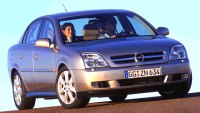 The
automotive world changes rapidly. When I wrote about the outgoing
second-generation
Vectra in 1998, it was still the European top seller in its class,
beating
the contemporary Ford Mondeo and Peugeot 406. During the last 4 years,
the car slipped gradually behind Volkswagen Passat and new Mondeo. If
not
because of fleet and company car sales, it could be worse. Why did it
fall
so dramatically ? most believe due to its lack of image. If I mention
Passat,
you will think of quality; If we talk about Mondeo, you will think of
handling;
Renault Laguna may be linked to ride quality; Nissan Primera will
remind
you how a spaceship look like; Holden Commodore is all about space;
Chrysler
Sebring is, well, famous of cheapness. At least it has an advantage. So
what about Vectra ? it had no character at all. It scored 70 or 80
marks
in every department but it did not shine in any area either. The
automotive world changes rapidly. When I wrote about the outgoing
second-generation
Vectra in 1998, it was still the European top seller in its class,
beating
the contemporary Ford Mondeo and Peugeot 406. During the last 4 years,
the car slipped gradually behind Volkswagen Passat and new Mondeo. If
not
because of fleet and company car sales, it could be worse. Why did it
fall
so dramatically ? most believe due to its lack of image. If I mention
Passat,
you will think of quality; If we talk about Mondeo, you will think of
handling;
Renault Laguna may be linked to ride quality; Nissan Primera will
remind
you how a spaceship look like; Holden Commodore is all about space;
Chrysler
Sebring is, well, famous of cheapness. At least it has an advantage. So
what about Vectra ? it had no character at all. It scored 70 or 80
marks
in every department but it did not shine in any area either.
Despite that, Opel did not learn a lesson. What you see now might be a hugely improved Vectra, better than the old one in every way, but again it has no character. This is a common problem for many GM products. Some analysts criticized the giant company cares too much about surveys and without its own vision. Had product chief Bob Lutz arrived earlier, what we would have seen might be a completely different Vectra, but now we have to accept the reality: new Vectra is again a soulless machine.
Both front and rear suspensions are now mounted on subframe for NVH isolation, though this is just a predictable development that everybody else is doing. The front MacPherson struts are adapted from Astra, but now have cast aluminum control arms to improve ride quality. The rear is a new multi-link setup consisting of 3 lateral and 1 vertical link. New generation stability control called ESP+ can brake up to 3 wheels instead of 1, bringing quicker response. Lastly but not least, it is known that Rüsselsheim again seek help from Lotus for tuning the car’s handling.
The cabin is also a big improvement in terms of space and quality. Anyway, this is not a difficult task considering how poor the old Vectra was. Basically, the new cabin is not big by class standard, although it can swallow 5 six-footers. 2700mm wheelbase means that it can hardly challenge the huge rear legroom of Mondeo and Passat, while high seating position does not favour headroom. In addition to the less-airy environment, the Vectra feels much smaller than its main rivals. Quite surprisingly, the cabin employs plastic materials of rather good quality and assembly is faultless. Switches and buttons have damping to pass the touch feel test. Design, however, is as dull as ever. Look ! the whole dashboard, console, door panels and even air ventilations are dark and rectangular, having no sense of beauty at all. Really can’t believe that its designer came from Audi. The control panel at center console was carried over straight from Omega, so it is a little bulky to the smaller car. However, the ugliest element is the tiny LCD screen mounted high between a pair of air vents. Isn’t it too small ? Despite of the compact size and the aforementioned weight-saving materials, the Vectra is a complete failure in terms of weight control. Installed with an all-alloy 2.2-litre four and it weighs 1455kg. A Mondeo 2.0 weighs almost 100kg less, thus goes quicker (0-60 needs 9 sec versus 10 sec) and drinks less fuel (35.3mpg versus 32.8mpg). It is a shame, because the 2.2 engine has always been a smooth and willing performer in other models. It just fail to overcome the weight problem. As a result, forget about the company-car-friendly 1.8 (120hp) and a pair of outdated turbo diesel (still no common-rail). For better performance you have to wait for a new light-turbo 2.0 derived from the all-alloy 2.2 or the performance flagship GTS, which is powered by Omega’s 3.2-litre V6 good for 211 horsepower. We shall wait for a test report to see whether the extra burden at nose will deteriorate handling, but it could be a potential rival to Mondeo ST220. Expect 0-60 in 7.5 and a top speed of 154mph. How does the new Vectra drive ? it has some traditional goods and bads of German saloons. Suspension setup is firmer than Laguna, though not as firm as Mondeo. This give it a good high-speed stability and motorway refinement. The latter is enhanced by the vibration-free steering, strong chassis and muted cabin. Vectra enjoys motorway cruising, but once it enter twisty roads it fails to deliver as much fun and eagerness as Mondeo. While the driver is busy dealing with the slightly notchy gearshift, he will find the electro-hydraulic steering - though precise and well-weighted - lacks communication. Not only lacks the sharpness of Mondeo, even loses to the Laguna. Again,
this is a characterless Vectra. Overall speaking, it has similar
abilities
to Laguna, C5 and Passat, if eclipsed by Mondeo in all area. However,
because
of the lack of character I would rate it below its rivals.
|
| The above report was last updated on 23 Mar 2002. All Rights Reserved. |
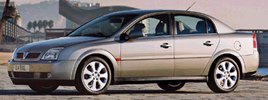 We
said the new car has huge improvements over the old one. This start
from
a new chassis. The new Vectra is the first product built out of GM’s
Epsilon
global platform which will be shared with new Saab 9-3 and others.
Being
100mm longer, 90mm wider, 35mm taller and boosting 60mm longer
wheelbase,
the new car can enlarge its cramped cabin considerably. At the same
time,
chassis (torsional) rigidity has been up by 74% to 18,000 Nm / degree.
This is achieved by using large amount of high-strength steel in the
structure.
The Vectra has as much as 52% of its monocoque body made of
high-strength
steel, compare with 37% of the new Mercedes E-class. On the other hand,
to compensate the weight gain, it also employs quite a lot of aluminum
(around 100kg, mostly in suspensions and a few panels) as well as
magnesium.
We
said the new car has huge improvements over the old one. This start
from
a new chassis. The new Vectra is the first product built out of GM’s
Epsilon
global platform which will be shared with new Saab 9-3 and others.
Being
100mm longer, 90mm wider, 35mm taller and boosting 60mm longer
wheelbase,
the new car can enlarge its cramped cabin considerably. At the same
time,
chassis (torsional) rigidity has been up by 74% to 18,000 Nm / degree.
This is achieved by using large amount of high-strength steel in the
structure.
The Vectra has as much as 52% of its monocoque body made of
high-strength
steel, compare with 37% of the new Mercedes E-class. On the other hand,
to compensate the weight gain, it also employs quite a lot of aluminum
(around 100kg, mostly in suspensions and a few panels) as well as
magnesium.  Exterior
design is another area of improvement. Its high shoulder line and bold
profile are obviously learned from Audi A4, while the swoopy roof of
the
hatchback model has some resemblance to A6. However, the dull corporate
grille and big headlamps do not deliver much elegant feel. The most
beautiful
part is the tail, where the sharp taillights match perfectly with the
boot
lid. Model name and company logo are stamped on a chromed, horizontal
strip
at the lower edge of the boot lid, which is a nice detail.
Exterior
design is another area of improvement. Its high shoulder line and bold
profile are obviously learned from Audi A4, while the swoopy roof of
the
hatchback model has some resemblance to A6. However, the dull corporate
grille and big headlamps do not deliver much elegant feel. The most
beautiful
part is the tail, where the sharp taillights match perfectly with the
boot
lid. Model name and company logo are stamped on a chromed, horizontal
strip
at the lower edge of the boot lid, which is a nice detail.
 Vectra
GTS (Vauxhall calls it GSi instead) is the hottest version of Vectra
family.
If you remember, the last generation Vectra GSi was powered by a
highly-modified
195hp 2.5-litre V6. It was already seen as powerful enough for a
front-drive
family saloon. Today, GTS sought power from a much larger 3.2-litre V6,
actually coming from the big Omega. Why? because the whole new Vectra
lineup
becomes so heavy - in the GTS trim it weighs a hefty 1578kg or some
120kg
more than direct rival Ford Mondeo ST220! no wonder it needs a lot more
cubic centimeters to achieve the same level of performance.
Disappointingly,
the 3175cc V6 is not tuned any hotter than the executive-class Omega.
In
fact, installing transversely instead of longitudinally into the
Vectra’s
engine bay actually limits its exhaust routing thus loses a few
horsepower
to a total of 211hp. With 221lbft of torque, it is tractable at low rev
yet provides remarkable overtaking power at mid-range. However, it is
too
quiet and civilized for a performance car like the GTS.
Vectra
GTS (Vauxhall calls it GSi instead) is the hottest version of Vectra
family.
If you remember, the last generation Vectra GSi was powered by a
highly-modified
195hp 2.5-litre V6. It was already seen as powerful enough for a
front-drive
family saloon. Today, GTS sought power from a much larger 3.2-litre V6,
actually coming from the big Omega. Why? because the whole new Vectra
lineup
becomes so heavy - in the GTS trim it weighs a hefty 1578kg or some
120kg
more than direct rival Ford Mondeo ST220! no wonder it needs a lot more
cubic centimeters to achieve the same level of performance.
Disappointingly,
the 3175cc V6 is not tuned any hotter than the executive-class Omega.
In
fact, installing transversely instead of longitudinally into the
Vectra’s
engine bay actually limits its exhaust routing thus loses a few
horsepower
to a total of 211hp. With 221lbft of torque, it is tractable at low rev
yet provides remarkable overtaking power at mid-range. However, it is
too
quiet and civilized for a performance car like the GTS.
 Undoubtedly,
Opel Vectra OPC, or Vauxhall Vectra VXR, is the hottest version of the
Vectra family. The question is whether Opel Performance Center can
convert the boring character of the regular Vectra into a really
inspiring drive.
Undoubtedly,
Opel Vectra OPC, or Vauxhall Vectra VXR, is the hottest version of the
Vectra family. The question is whether Opel Performance Center can
convert the boring character of the regular Vectra into a really
inspiring drive.  A
few years ago, mainstream car makers realized they no longer own the
big
car markets. Premium brands like BMW, Audi and Mercedes ate into the
market
and eventually led to the death of Ford Scorpio. In the view of dark
future,
GME cancelled its plan for the Omega replacement, leaving Vectra to be
the largest car in its future lineup. That leaves a black hole above
the
Vectra.
A
few years ago, mainstream car makers realized they no longer own the
big
car markets. Premium brands like BMW, Audi and Mercedes ate into the
market
and eventually led to the death of Ford Scorpio. In the view of dark
future,
GME cancelled its plan for the Omega replacement, leaving Vectra to be
the largest car in its future lineup. That leaves a black hole above
the
Vectra.
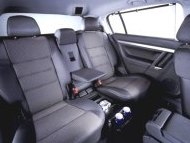 In
the name of "life-style", the rear seat becomes a 2-seater - it does
have
a middle seat, but it is too high, narrow and hard for anyone to sit in
comfort. Well, the Signum is no wider than the Vectra, so it won’t sit
3 people side by side in comfort anyway. Using a 2-seater rear bench
helps
releasing shoulder room of each passenger and enables the installation
of a refrigerator, a storage cubby and a pair of fold tables under the
middle rear seat. Flip the seat base and all these are revealed. So,
this
is "life-style". As for "luxury", Signum offers an optional DVD player
with LCD screens and separate audio controls for rear passengers.
In
the name of "life-style", the rear seat becomes a 2-seater - it does
have
a middle seat, but it is too high, narrow and hard for anyone to sit in
comfort. Well, the Signum is no wider than the Vectra, so it won’t sit
3 people side by side in comfort anyway. Using a 2-seater rear bench
helps
releasing shoulder room of each passenger and enables the installation
of a refrigerator, a storage cubby and a pair of fold tables under the
middle rear seat. Flip the seat base and all these are revealed. So,
this
is "life-style". As for "luxury", Signum offers an optional DVD player
with LCD screens and separate audio controls for rear passengers.
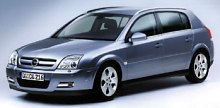 Unfortunately,
all these limited "life-style" and "luxury" features are achieved in
the
price of dynamics. The Signum is not only heavier and slower than the
equivalent
Vectra, but its soft suspension and loss of chassis rigidity generate
severe
problems to handling as well as ride quality. It rolls heavily in
corners.
Its body is unsettling over bumpy roads where Vectra would damp out. As
speed rise, NVH transmitted into the cabin becomes increasingly
annoying.
Besides, the steering is even more lifeless than the Vectra’s.
Unfortunately,
all these limited "life-style" and "luxury" features are achieved in
the
price of dynamics. The Signum is not only heavier and slower than the
equivalent
Vectra, but its soft suspension and loss of chassis rigidity generate
severe
problems to handling as well as ride quality. It rolls heavily in
corners.
Its body is unsettling over bumpy roads where Vectra would damp out. As
speed rise, NVH transmitted into the cabin becomes increasingly
annoying.
Besides, the steering is even more lifeless than the Vectra’s.
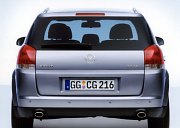 Signum
is powered by the same range of engines as Vectra, starting from a
2.2-litre
four (now added with direct-injection to boost 155hp), a 175hp
2.0-litre
light-turbo (from Saab 9-3), a 211hp 3.2-litre V6, a pair of outdated
four-cylinder
diesel and a 177hp common-rail 3.0 V6 diesel turbo (from Isuzu). The
2.0
turbo is the pick of the range, for it offers respectable torque and
good
refinement while returning remarkable consumption. The V6 won’t add
much
higher performance, just add more weight at the nose and deteriorate
handling.
Signum
is powered by the same range of engines as Vectra, starting from a
2.2-litre
four (now added with direct-injection to boost 155hp), a 175hp
2.0-litre
light-turbo (from Saab 9-3), a 211hp 3.2-litre V6, a pair of outdated
four-cylinder
diesel and a 177hp common-rail 3.0 V6 diesel turbo (from Isuzu). The
2.0
turbo is the pick of the range, for it offers respectable torque and
good
refinement while returning remarkable consumption. The V6 won’t add
much
higher performance, just add more weight at the nose and deteriorate
handling.